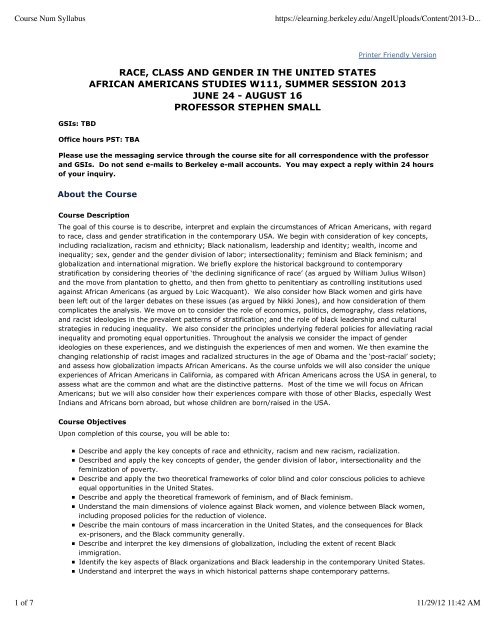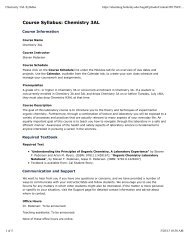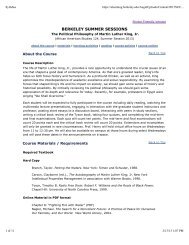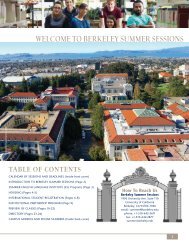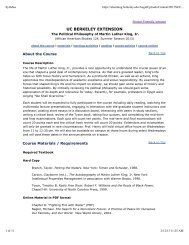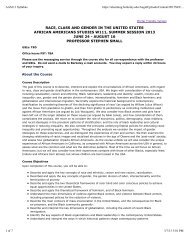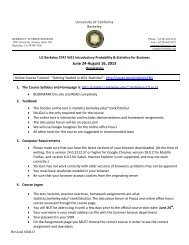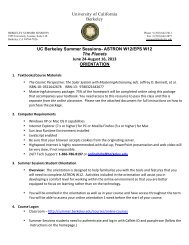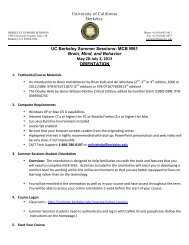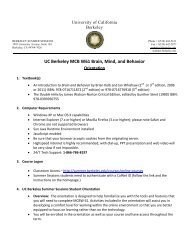Course Num Syllabus - Berkeley Summer Sessions
Course Num Syllabus - Berkeley Summer Sessions
Course Num Syllabus - Berkeley Summer Sessions
Create successful ePaper yourself
Turn your PDF publications into a flip-book with our unique Google optimized e-Paper software.
<strong>Course</strong> <strong>Num</strong> <strong>Syllabus</strong>https://elearning.berkeley.edu/AngelUploads/Content/2013-D...GSIs: TBDPrinter Friendly VersionRACE, CLASS AND GENDER IN THE UNITED STATESAFRICAN AMERICANS STUDIES W111, SUMMER SESSION 2013JUNE 24 - AUGUST 16PROFESSOR STEPHEN SMALLOffice hours PST: TBAPlease use the messaging service through the course site for all correspondence with the professorand GSIs. Do not send e-mails to <strong>Berkeley</strong> e-mail accounts. You may expect a reply within 24 hoursof your inquiry.About the <strong>Course</strong><strong>Course</strong> DescriptionThe goal of this course is to describe, interpret and explain the circumstances of African Americans, with regardto race, class and gender stratification in the contemporary USA. We begin with consideration of key concepts,including racialization, racism and ethnicity; Black nationalism, leadership and identity; wealth, income andinequality; sex, gender and the gender division of labor; intersectionality; feminism and Black feminism; andglobalization and international migration. We briefly explore the historical background to contemporarystratification by considering theories of ‘the declining significance of race’ (as argued by William Julius Wilson)and the move from plantation to ghetto, and then from ghetto to penitentiary as controlling institutions usedagainst African Americans (as argued by Loic Wacquant). We also consider how Black women and girls havebeen left out of the larger debates on these issues (as argued by Nikki Jones), and how consideration of themcomplicates the analysis. We move on to consider the role of economics, politics, demography, class relations,and racist ideologies in the prevalent patterns of stratification; and the role of black leadership and culturalstrategies in reducing inequality. We also consider the principles underlying federal policies for alleviating racialinequality and promoting equal opportunities. Throughout the analysis we consider the impact of genderideologies on these experiences, and we distinguish the experiences of men and women. We then examine thechanging relationship of racist images and racialized structures in the age of Obama and the ‘post-racial’ society;and assess how globalization impacts African Americans. As the course unfolds we will also consider the uniqueexperiences of African Americans in California, as compared with African Americans across the USA in general, toassess what are the common and what are the distinctive patterns. Most of the time we will focus on AfricanAmericans; but we will also consider how their experiences compare with those of other Blacks, especially WestIndians and Africans born abroad, but whose children are born/raised in the USA.<strong>Course</strong> ObjectivesUpon completion of this course, you will be able to:Describe and apply the key concepts of race and ethnicity, racism and new racism, racialization.Described and apply the key concepts of gender, the gender division of labor, intersectionality and thefeminization of poverty.Describe and apply the two theoretical frameworks of color blind and color conscious policies to achieveequal opportunities in the United States.Describe and apply the theoretical framework of feminism, and of Black feminism.Understand the main dimensions of violence against Black women, and violence between Black women,including proposed policies for the reduction of violence.Describe the main contours of mass incarceration in the United States, and the consequences for Blackex-prisoners, and the Black community generally.Describe and interpret the key dimensions of globalization, including the extent of recent Blackimmigration.Identify the key aspects of Black organizations and Black leadership in the contemporary United States.Understand and interpret the ways in which historical patterns shape contemporary patterns.1 of 7 11/29/12 11:42 AM
<strong>Course</strong> <strong>Num</strong> <strong>Syllabus</strong>https://elearning.berkeley.edu/AngelUploads/Content/2013-D...<strong>Course</strong> Materials / RequirementsReading RequirementsBooksMichael K Brown, Martin Carnoy, Elliott Currie, Troy Duster, David B. Oppenheimer, Marjorie M. Shultz and DavidWellman - Whitewashing Race. The Myth of a Color-Blind Society, 2003.Nikki Jones - Between Good and Ghetto: African-American Girls and Inner-City Violence, 2010.Michelle Alexander - The New Jim Crow. Mass Incarceration in the Age of Colorblindness, The New Press, 2010.Online readings in pdf formatBarak Obama – Speech on RaceStephen Small – RacializationRobert Miles and Stephen Small – Racism and EthnicityOliver and Shapiro – Wealth and Income, Chapter OneLoic Wacquant – The New ‘Peculiar Institution’Kimberlé Crenshaw – Mapping the MarginsAmott and Matthaei – GenderNielson – Work and gender division of laborAudre Lorde – Age, Race, Class and SexHull, Scott, Smith – Black Feminist StatementPatricia Hill Collins – Black Women’s Community WorkJohn Logan – African and Caribbean Immigration to the USALearning ActivitiesThe following learning activities will be used:Commentary topics (multimedia lectures)Reading assignments (textbooks and articles in PDF format)VideosDiscussion assignments (forum)Midterm Exam (online)Final Exam (proctored)Method of Instruction or Learning ActivitiesEach student will be expected to fully participate in the course including daily reading, watching the multimedialecture presentations, interacting with peers in discussions forums, taking one quiz, completing the mid-term,and final examinations.Participation = 20 %Quiz = 10 %Mid-term = 30 %Final examination = 40 %Extensions and incompletes will only be granted in rare circumstances; and only within University guidelines.ReadingsRead the assigned chapters for each module. View the assigned multimedia presentations. The module’s learningobjectives and multimedia lectures will provide an overview to assist students in focusing their study. Readingsand multimedia (PPTs, video links, pdfs) are listed under each respective module and subsequent lectures (thereare four lectures for modules 1-7, and three lectures for module 8). Specific reading assignments are listedunder “Learning Activities” for each module.2 of 7 11/29/12 11:42 AM
<strong>Course</strong> <strong>Num</strong> <strong>Syllabus</strong>https://elearning.berkeley.edu/AngelUploads/Content/2013-D...Multimedia LecturesAll links to PowerPoint lectures and video links can be located under “Learning Activities” for each module.Virtual Office HoursThe professor and GSIs hold virtual office hours when students can communicate in real time (synchronously).These “chats” are optional and are to be used to pose questions about the course material. Students chat withthe professor or GSI during their office hours by clicking on “Communication” in the left hand menu, then goingto the “Live Chat”. These chats are optional; no points are awarded for participation. Days and times for VirtualOffice Hours are posted on the course site in multiple places and listed at the top of the syllabus.You may also communicate through the course messaging service. Please allow 24 hours for all replies. Thatsaid, do not wait until the last minute if you have substantive questions about the course material for upcomingdue dates.Participation Discussion Forum (20%)As indicated in the syllabus, 20% of the final grade will be reflective of your level of participation in thediscussion forum. Because this is an online course, and we do not meet regularly, these discussions are veryimportant and provide students a generous and collaborative intellectual environment in which to work. Theobjective of these discussions is to provide students with the opportunity to discuss material that might be noveland surprising, and discussions help with the comprehension of new concepts. This is an opportunity to engagewith the readings and PPTs and share reflections, observations, and comments. Students are encouraged toquestion and critique, and go beyond just summarizing to discuss with each other the implications andimportance of the material. Personal opinions are welcome, but should be secondary.Each student should post a minimum of at least 1 succinct paragraph for each question in the module. Eachmodule has two questions. Please remember that while your posts need not be lengthy, they must be written ina formal academic style respecting the rules of grammar and spelling. Here is a sample post to demonstrate thequality and style that are expected:“The history of racialization shapes present aspects of racialization because it gives us context;we’re able to mark how far we’ve come from the earlier and more narrow ways of ascribing racialdefinitions to people, ideologies or institutions. I’m thinking in particular of Professor Small’sexample of the 2000 US Census—how people were able to choose more than one box to define theirown ethnicity. In contrasting this with the “one drop rule,” we can clearly delineate our history’songoing redefinition of race. Scientists, politicians and the public play an enormous role in definingthese concepts because each of these entities inform one other in redefining race.”To post your responses, click on the New Post button. If you are responding to other students please reply totheir posts directly. And all students are required to be respectful and courteous to each other. Acknowledgeand show respect for the diversity of opinions presented by your classmates. Discussions will be monitoredclosely by the professor and GSIs who will intervene periodically.The discussions will be open for a limited time period, which will correspond to the module we are covering foreach week (see below for all due dates and the list of questions). Each module’s discussion questions will beavailable for one week, and then locked. Your answers to the discussion questions will be due each Thursday atmidnight. You must reply to two other students and these replies are due the following Sunday at midnight.You are encouraged to post and reply anytime throughout the week, as long as you meet your weeklydeadlines.The goal of this learning activity is to encourage enthusiastic participation IN DUE TIME. It is required thatstudents keep up with the program set up in the syllabus. Diligent participation in the discussion forum will helpstudents do well on the quiz, midterm, and final.Professor Small and your GSIs will monitor the discussion posts regularly, intervening when necessary, andproviding feedback periodically. While each week’s posts will not be graded, your participation grade will bebased on the quality and quantity of your overall participation. This is your opportunity to “speak up”, as if youare in a discussion section in a classroom. In an online forum, the content, relevance, and number of posts and3 of 7 11/29/12 11:42 AM
<strong>Course</strong> <strong>Num</strong> <strong>Syllabus</strong>https://elearning.berkeley.edu/AngelUploads/Content/2013-D...responses will determine your overall participation grade.Please respect the discussion forum as an intellectual space. The discussion forum may NOT be usedfor the transmission of personal messages between students or to the professor or GSIs. For thelatter, the course's e-mail messaging service must be used.Quiz (Date TBA) 10%There will be 1 quiz based on short answer questions. The quiz will consist of 4 questions. You must answer twoquestions from this total. Once you begin a quiz, you will have 30 minutes to complete it. The quiz will beavailable for 24 hours.Mid-term Examination (Date TBA) 30%The mid-term examination will consist of essay and short answer questions.Final Examination (Thursday, August 15) 40%After you have completed all the other requirements, you will take a three-hour, proctored, closed book finalexam, on Thursday, August 15th, (Time), in TBA.There will be no make-up exam. You must pass the final exam to receive credit for the course. Students musttake the final examination in person or possibly arrange to have the examination proctored if you cannot cometo campus. Please contact your Program Coordinator Tracie Littlejohn at tlittlejohn@unex.berkeley.edu to makealternative arrangements. Off-site proctors must be approved prior to July 26, 2013.Remember to carefully review the university’s policies on Academic Integrity and Student Conduct.Plagiarism and cheating will not be tolerated. Any violation of University policy will result in failureof course and possible academic suspension.Student LoungeThe Student Lounge is our place for informal discussion, a place to create new topic threads and share commonissues or experiences, class-related or not. Please use that forum to post questions about the course material,answers to help other students, and general FAQs so that all students in the course may benefit from theexchange.Technical SupportIf you are having technical difficulties please alert one of the GSIs immediately. However, understand thatneither the GSIs, nor the professor can assist you with technical problems. You must call or e-mail tech supportand make sure you resolve any issues immediately. Be sure to document (save e-mails and transactionnumbers) for all interactions with tech support. Extensions and late submissions will not be accepted dueto “technical difficulties”.For 24/7 Tech Help Support:Call 1-866-786-8197 or e-mail onlinehelp@berkeley.eduCredit Requirements<strong>Course</strong> grades are based on the following:Participation (Discussion Forum) 20%Quiz 10%Midterm Exam (online) 30%Final Exam 40%You must pass the examination to pass the course.4 of 7 11/29/12 11:42 AM
<strong>Course</strong> <strong>Num</strong> <strong>Syllabus</strong>https://elearning.berkeley.edu/AngelUploads/Content/2013-D...LetterGradeA+ A A- B+ B B- C+ C C- D+ D- FPercentage 100 94-99 90-93.9 87-89.9 84-86.9 80-83.9 77-79.9 75-76.9 74.9-70 69.9-67 66.9-65
<strong>Course</strong> <strong>Num</strong> <strong>Syllabus</strong>https://elearning.berkeley.edu/AngelUploads/Content/2013-D...1. In what ways does Obama’s election prove the US is post-racial?2.Why is the difference between sex and gender important? Discuss poverty, prisons, labor, and mediaimages.Discussion posts due by Thursday June 21, 11:55pm. Replies due Sunday June 24, 11:55pm.WEEK TWO: RACE AND ETHNICITY – CONCEPTS AND EXAMPLESQuestions:1.2.Why is the difference between race and ethnicity important?What is ‘white habitus’ and how does it work? Discuss ‘old racism’ vs. ‘new racism’.Discussion posts due by Thursday June 28, 11:55pm. Replies due Sunday July 1, 11:55pm.WEEK THREE: RACE, GENDER AND FEMINISM – CONCEPTS AND EXAMPLESQuestions:1.What key societal obstacles confront women? How are production and reproduction mutually reinforced?2.In thinking about intersectionality and the racial division of gender, how do legal, economic, and socialinequality relate to one another?Discussion posts due by Thursday July 5, 11:55pm. Replies due Sunday July 8, 11:55pm.WEEK FOUR: EVIDENCE AND EXPLANATIONS OF RACIAL INEQUALITYQuestions:1.2.What is the role of the individual in theories of racial realism?What are the critiques of color blind policies and race conscious policies?Discussion posts due by Thursday July 12, 11:55pm. Replies due Sunday July 15, 11:55pm.WEEK FIVE: THE PRISON AND ITS SOCIAL TENTACLESQuestions:1.2.What key problems confront ex-prisoners and how do they escape these problems?What are the differences between the plantation and prison as controlling institutions?Discussion posts due by Thursday July 19, 11:55pm. Replies due Sunday July 22, 11:55pm.WEEK SIX: RACE AND GENDER IN THE INNER CITYQuestions:1.In what ways does poverty shape inner city violence?6 of 7 11/29/12 11:42 AM
<strong>Course</strong> <strong>Num</strong> <strong>Syllabus</strong>https://elearning.berkeley.edu/AngelUploads/Content/2013-D...2.How does intersectionality shape violence against Black women and how do they respond/react toviolence?Discussion posts due by Thursday July 26, 11:55pm. Replies due Sunday July 29, 11:55pm.WEEK SEVEN: STRATIFICATION AND GLOBALIZATIONQuestions:1.How do the Black wealthy compare with the white wealthy?2.In what ways does globalization adversely impact African Americans? In what ways does globalizationbenefit African Americans?Discussion posts due by Thursday August 2,11:55pm. Replies due Sunday August 5, 11:55pm.WEEK EIGHT: BLACK MOBILIZATION, ORGANIZATIONS AND LEADERSHIPNo discussion posts due, but some questions to think about as you study for the final:1.What are the priorities of Black women, especially in leadership?2.In what ways is the Black experience in California unique? In what ways is the Black experience inCalifornia common?End of <strong>Course</strong> EvaluationUC <strong>Berkeley</strong> Extension is committed to improving our online courses and instruction. Please take a few minutesto participate in our End of <strong>Course</strong> Evaluation to share your opinions about this course. We are interested in youronline learning experience, and your candid feedback will help us plan for the future and make improvements.Please take the evaluation before your course end date.The evaluation does not request any personal information, and your responses will remain strictly confidential.To access the evaluation, please follow the link near the bottom of the Modules tab page.© 2012 UC Regents. All rights reserved.7 of 7 11/29/12 11:42 AM


